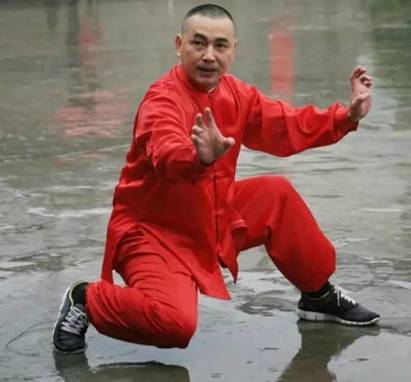Li Family System of Hakka Martial ArtsThe Li Family System of Hakka Martial Arts is centred today in the Meixian District of Meizhou City, which is in the Wuhua (五华) area (of Northeast Guangdong province). The primary ancestor of this style is Master Li Tieniu (李铁牛) [1778-1874] – with ‘Tieniu’ translating as ‘Iron Ox’. He was from the Water Camp Town (水寨镇 – Shuizhai Zhen) of Wuhua. Legend states that an ancestor of Li Tieniu (during the reign of Qing Dynasty Emperor Jiaqing 1796-1820) was conducting business in the Fujian and Zhejiang provincial areas, when he met a very virtuous and learned Shaolin monk who taught him this style. Li Tieniu passed on this art to his son named Li Chongsi (李崇寺) - with ‘Chongsi’ meaning to ‘Venerate the Temple’. Li Chongsi in turn passed on this art to his son named Li Guangren (李光壬) [1864—1940] – with ‘Guangren’ meaning ‘Bright Art’.
Li Guangren spent much time in his youth learning from both his grandfather and father, and because of this good instruction (and his extraordinary courage) he attained a very high level of martial skill, and inherited the teachings passed on from master to disciple, down through the generations. When he was a teenager, he accompanied his father to Shantou (汕头), and then on to Jieyang (揭阳), Jiexi (揭西), Puning (普宁), Huidong (惠东), Chaoan (潮安), and Chaoyang (潮阳) Counties, where they taught their martial art to thousands of disciples. When he was middle-aged, he was asked to go to Thailand (泰国 – Tai Guo) to open a martial arts training hall. Then, in 1933, one of Master Li Tieniu’s outstanding students named Hong Yian (洪义安) – with ‘Yian’ meaning ‘Great Righteousness’ – took part in a ‘challenge’ martial arts tournament. Due to his martial prowess both at the time, and during the war years, Hong Yian’s reputation as an excellent martial arts master spread far and wide. In 1935, a person named Li Huatong (黎华通) – with ‘Huatong’ meaning ‘Immense Culture’ – who was from Pingyuan (平远) County, accompanied Li Guangren to Flood Sun Town (洪阳镇 – Hong Yang Zhen), situated in Puning County, where in the Liusha (流沙) area they established an unprecedented 16 Li Style martial arts training halls. Since those days, the Li Family System of Hakka Martial Arts has spread to areas and counties of Chaozhou (潮汕), Meizhou (梅州), Wuhua (五华), Xingning (兴宁), Fengshun (丰顺), Pingyuan (平远), and Shantou (汕头). It has also spread to Hong Kong (香港) where it has taken a firm root, and throughout Southeast Asia. The Li Family System of Hakka Martial Arts has many set routines (or ‘forms’), and because of this it is considered a good, all-round style. Its movements are close-in, compact, and very powerful due to efficient positioning and precise targeting. The stance and footwork is secure and steady, so that the hand and foot strikes are delivered with a deadly accuracy that is designed to ‘pierce’ the target. Through strong stance work, the Li practitioner is able to fight very effectively. Through body-conditioning and concentration exercises, ‘jin’ (劲) or ‘powerful vigour’, and ‘li’ (力) or ‘powerful strength’, are fully cultivated. The forms develop very powerful (and yet fluid) hand and foot techniques. Jin is developed through all the forms, examples of which are named the ‘Swift Step Fist’ (驰步拳 – Chi Bu Quan), the ‘Swallow Spit Fist’ (吞吐拳 – Tun Tu Quan), and ‘Suspended Piercing Fist’ (吊插拳 – Diao Cha Quan), and so on. ©opyright: Adrian Chan-Wyles (ShiDaDao) 2016. Original Chinese Language Source Article: http://mp.weixin.qq.com/s?__biz=MzAxNDE2MTIwMQ==&mid=400399456&idx=5&sn=530124aacfe6cd3b92ff46c7394532e6&3rd=MzA3MDU4NTYzMw==&scene=6#rd 李家教 李家教源于梅州市梅县区、五华一带,主要传人是五华水寨镇的李铁牛(1778—1874),相传李铁牛的祖先于清朝嘉庆十年,经商于闽浙一带,于一少林僧相义甚厚,习得此拳,李铁牛传其子李崇寺,李崇寺又传子李光壬。 李光壬(1864—1940年),自幼得祖父和父亲的悉心传心传受,技艺精熟、胆识过人,少年时期随父赴汕头、揭阳、揭西、普宁、惠东、潮安、潮阳等县,授徒数以千计。 中年时,曾应聘到暹罗(泰国)开馆受徒,一九三三年,李光壬曾携高徒洪义安前往参加擂台赛,战誉而归,洪义安当时是国术社的中坚人物,威望甚高。 一九三五年,平远县人黎华通随李光壬到普宁县洪阳镇,就在洪阳、流沙一带开办了十六间武馆,盛况空前。 李家教流传于潮汕及梅州地区、五华、兴宁、丰顺、平远和汕头地区各县,以及香港等地,更远播东南亚各国。 风格特点是套路多、结绝完整、动作紧凑、稳扎稳打、劲力饱满。套路以步法、手法、劲法而命名,如驰步拳、吞吐拳、吊插拳等。 |
